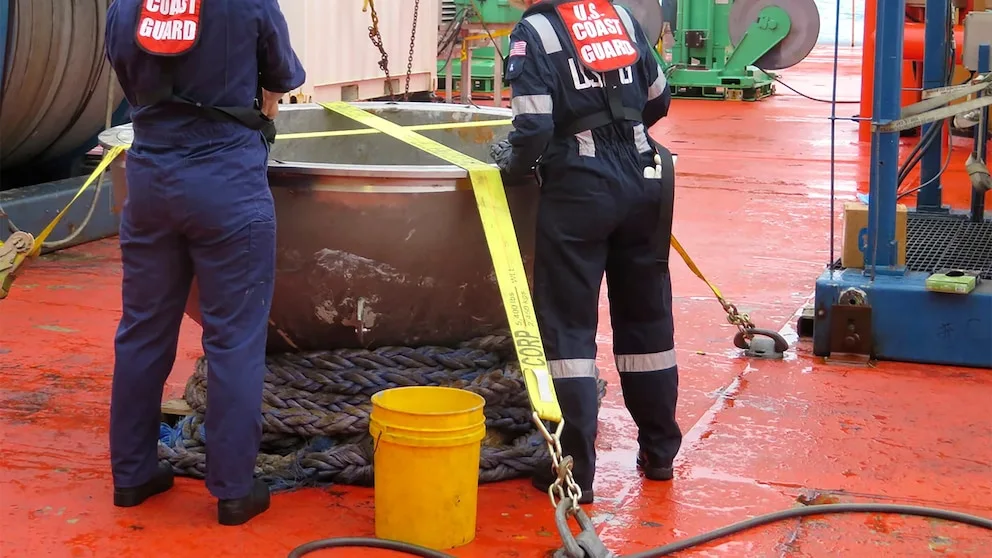The Coast Guard has recovered remaining debris, including presumed human remains, from a submersible that imploded on its way to explore the wreck of the Titanic, killing all five onboard, deep beneath the Atlantic Ocean’s surface, officials said Tuesday.
The Coast Guard said that the recovery and transfer of remaining parts was completed last Wednesday, and a photo showed the intact aft titanium endcap of the 22-foot (6.7-meter) vessel. Additional presumed human remains were carefully recovered from within Titan’s debris and transported for analysis by U.S. medical professionals, the Coast Guard said.
The salvage mission conducted under an agreement with the U.S. Navy was a follow-up to initial recovery operations on the ocean floor roughly 1,600 feet (488 meters) away from the Titanic, the Coast Guard said.
The new materials were offloaded at an unnamed port.
The Coast Guard previously said it recovered presumed human remains along with parts of the Titan after the debris field was located at a depth of 12,500 feet (3,800 meters).
Investigators believe the Titan imploded as it made its descent into deep North Atlantic waters on June 18.
I know the monies come from from different buckets and have wildly different orders of magnitude, but is there some sort of justification in continued recovery of a piece of shit sub full of the seemingly invulnerable ultra-rich that everyone knew was going to implode, versus, say, school lunches? Was there enough money to have paid SAT prep tutors in a handful of inner city schools in Chicago instead of dragging up the remains of one of the stupidest and most entitled public displays of sheer idiocy on the past handful of years?
Coast Guard is made to do salvage missions, many more important than this one. The cost of doing a mission like this is not large compared to the cost of acquiring and maintaining the equipment and crews necessary. It’s good practice, good PR, and may give technical insight that will be useful to civilian or military engineers working on deep-sea submersibles.
Basically, we’ve already spent 99% of the money necessary before even considering whether or not to undertake a particular salvage mission. You already bought the car - what’s a drive down to the next state over, really? Gas and some wear and tear?
I know it’s not even a rounding error in terms of budgets, but that’s really my point. I know enough about operations planning that in terms of actual dollars (not in the “a billion here, a billion there, and pretty soon you’re talking about real money” sense of the term dollars) that this operation was a significant expense, especially totaling from incident onset forward. I get that’s it’s already budgeted, it’s a great opportunity for hands on training on that rare class of work, and so on.
My point is that we’re prioritizing this as an ongoing operation over those other potential funding needs. That is, we are prioritizing the level of expense for this USCG training and recovery mission over what would be a proportionally massive investment in communities. Even from a purely economics standpoint, investment into communities pays back at a higher rate than more military expenditure.
I mean, it’s only estimated at a few million. 1.8 million so far, last I read. Even by community investment standards, that’s peanuts. I don’t know that “2 additional long-term teachers for one school in a low COL area” is really that much of a ‘proportionally massive’ investment in communities. And god help whoever has to make the decision who in the whole of the country gets that additional 1.8 million.
We have to clean up the trash.
Pretty sure the sub is beyond the environment
Good, thats where it should be if they designed it for the front to fall off.
The ocean floor is still part of the environment
No he means past that
If it’s beneath the ocean floor then it’s in the ocean floor and part of the environment
If you mean something else then use language that makes sense
This should clear things up for you. https://youtu.be/3m5qxZm_JqM?si=AGieN9b5Zg5UfVcy
So make the company and families of the rich fucks pay for it rather than the taxpayers
Make them destitute for all we care, whatever the cost is comes out of their pockets
what if they’re biodegradable?
They have to have regular training anyway, this way they get training and kinda do something useful. More useful than throwing shit overboard just to retrieve it
There is a lot we all can learn from this. The Coast Guard wants to know what happened so they’ll bring in their own people to help investigate. I wouldn’t trust any investigation the company is footing the bill for. Regulations are written in blood. Unfortunately, there are not a lot of regulations with privatized deep diving submarines like the Titan. It’s just not a large industry. As we learn what failed with the sub, both construction and administrative by the crew both in the sub and supporting it from the surface, recommendations for regulations can be developed. Commercial Diving has a lot of regulations they have to follow, but interestingly enough, parasailing doesn’t. These sub expeditions could be the next big industry as materials and technology become more cheaper. I’m not saying it’ll get cheap though. Just more people could access.
I just love the phrasing of this. “Presumed human remains.” So evacotive. Like these people were unmade so fucking hard we aren’t even sure we found what’s left of them.
This is typical in forensics. No one cannot make a definitive claim yet until a lab examines everything that’s been recovered. Most likely, that is what’s been found, yes, but confirming it takes time.
It’s also why you may hear a technician say that a sample is “consistent with” something (say, a person) when it is not possible to confirm where it came from.
Until relatively recently, a hair with no root was just about impossible to match to a single person, so that was a common example of that phrasing. Now, in some cases, it’s possible to get DNA from the strand.





